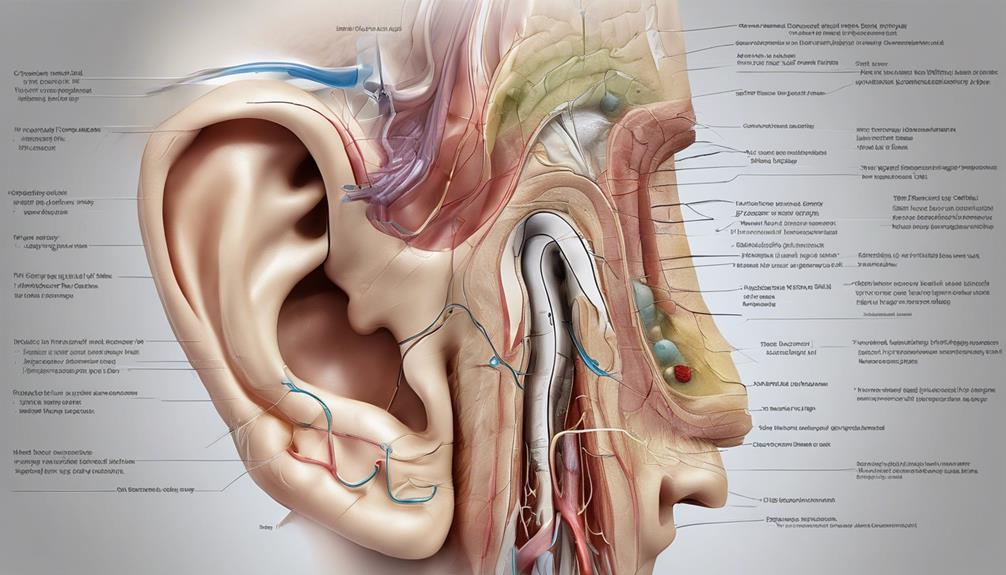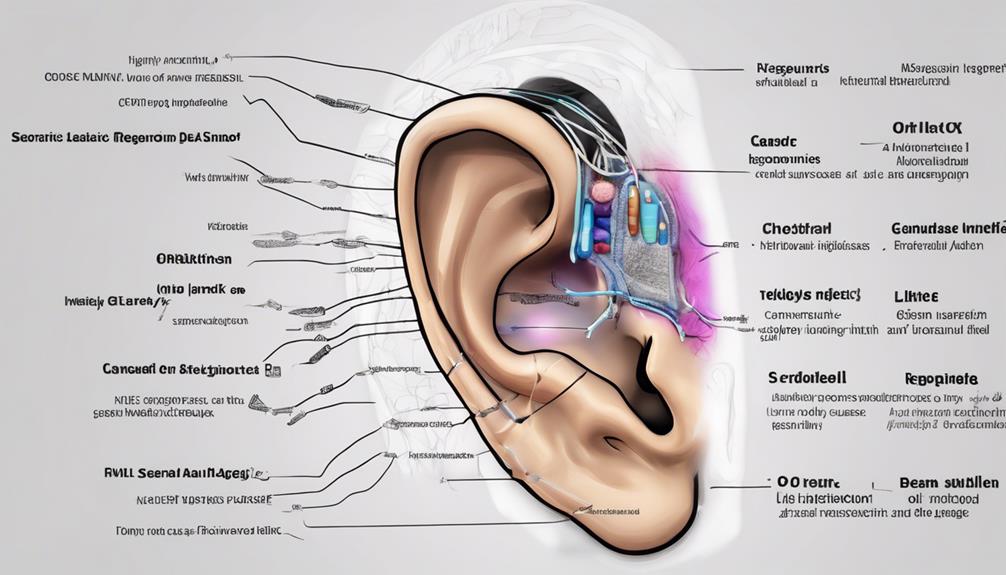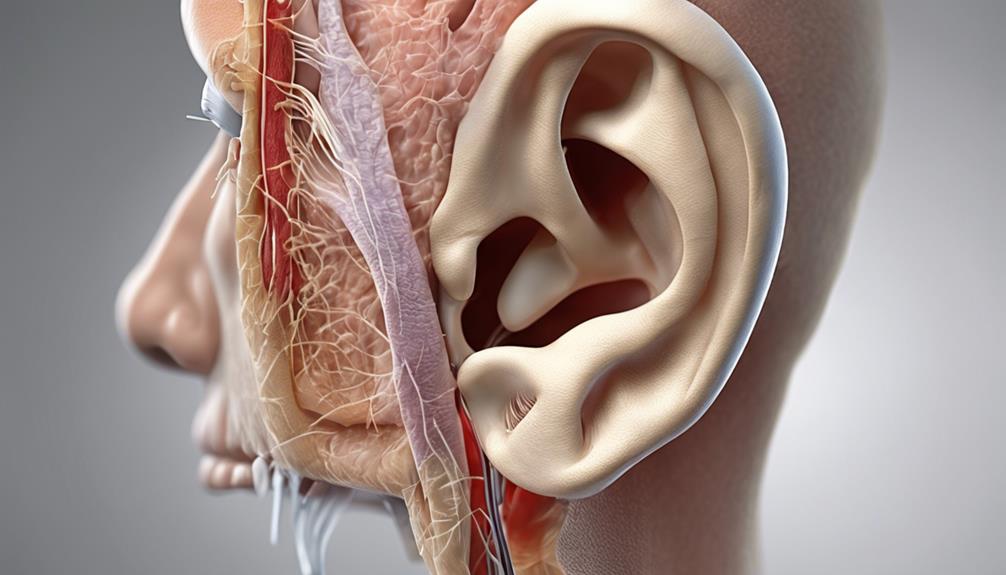When exploring the intricacies of mixed hearing loss, we encounter a mix of sensorineural and conductive components that require a customized treatment approach. The interplay of these factors unveils a multifaceted condition that can result from various factors such as loud noise exposure and anatomical abnormalities.
As we uncover the diverse triggers behind mixed hearing loss, a deeper understanding emerges, shedding light on personalized interventions to tackle this complex auditory challenge. Through unraveling the diverse causes and manifestations, a path unfolds towards tailored solutions, promising enhanced quality of life and auditory well-being.
Key Takeaways
- Mixed hearing loss results from a combination of conductive and sensorineural impairments.
- Genetic factors play a significant role in predisposing individuals to hearing loss.
- Treatment options include medication, surgery, hearing aids, and cochlear implants.
- Prevention involves avoiding loud noises, regular ear check-ups, and prompt treatment of underlying health issues.
Mixed Hearing Loss Overview
In understanding mixed hearing loss, we delve into the intricate interplay between conductive and sensorineural impairments. Mixed hearing loss is characterized by a combination of issues affecting both the outer or middle ear (conductive) and the inner ear (sensorineural). The causes of mixed hearing loss can vary widely, including factors such as chronic ear infections, otosclerosis, head trauma, genetic predispositions, or exposure to loud noises. The manifestation of symptoms may vary depending on the specific contributions of conductive and sensorineural components.
Diagnosing mixed hearing loss typically involves a comprehensive hearing test to assess the extent of both types of hearing impairments. Treatment options for mixed hearing loss are tailored to address the underlying factors contributing to the condition. These treatment strategies may include hearing aids, surgical interventions like tympanoplasty or stapedectomy, or cochlear implants for severe cases. Understanding the specific causes of mixed hearing loss is essential for developing effective management plans that optimize hearing outcomes for individuals with this complex condition.
Sensorineural Hearing Loss Causes

Sensorineural hearing loss causes encompass a range of factors, including aging, genetic predispositions, exposure to loud noises, and various medical conditions. When exploring the reasons behind sensorineural hearing loss, it's crucial to consider the following:
- Genetic factors play a significant role in predisposing individuals to sensorineural hearing loss.
- Exposure to loud noises over an extended period can damage the delicate hair cells in the inner ear, leading to hearing loss.
- Conditions like Meniere's disease, otosclerosis, and acoustic neuroma are known to cause sensorineural hearing loss.
- Certain medications, such as chemotherapy drugs and antibiotics, can have adverse effects on hearing health.
- Trauma to the head or inner ear, viral infections like meningitis, as well as underlying health issues like cardiovascular diseases, diabetes, and autoimmune disorders, can also contribute to sensorineural hearing loss.
Understanding these diverse causes is essential in managing and addressing sensorineural hearing loss effectively.
Conductive Hearing Loss Causes
Numerous factors contribute to conductive hearing loss, ranging from ear infections and abnormal bone growth to malformations in the ear structures. Ear infections, especially chronic ones, can lead to conductive hearing loss by causing inflammation and fluid buildup in the middle ear, affecting sound conduction. Similarly, earwax buildup can block the ear canal, preventing sound waves from reaching the eardrum effectively. Perforated eardrums, often a result of trauma or chronic infections, can disrupt the transmission of sound vibrations to the middle ear.
Abnormal bone growth in the ear, such as otosclerosis, can impede the movement of the stapes bone, further hindering sound transmission. Tumors in the middle ear, although less common, can also cause conductive hearing loss by interfering with the normal functioning of the ear structures. Malformations in the outer ear, middle ear, or ear canal from birth defects or genetic conditions can create obstacles for sound conduction, leading to hearing impairment. Understanding these various causes is crucial for proper diagnosis and treatment of conductive hearing loss.
Mixed Hearing Loss Symptoms

Mixed hearing loss symptoms manifest as a combination of difficulties in hearing soft sounds, understanding speech in noisy environments, and experiencing sensations of ear fullness, tinnitus, and dizziness. Patients with this condition may encounter fluctuations in hearing levels and struggle with the need for increased volume to perceive sounds effectively. Common challenges include difficulty in phone conversations and understanding dialogues in various settings. Seeking professional evaluation through audiometric tests is crucial for diagnosing and managing mixed hearing loss.
Below are key symptoms associated with mixed hearing loss:
- Difficulty hearing soft sounds and speech in noisy environments.
- Sensations of ear fullness.
- Tinnitus (ringing in the ears).
- Dizziness.
- Fluctuations in hearing levels and the need for increased volume.
Understanding these symptoms is essential for early detection and appropriate management of mixed hearing loss, which can significantly impact an individual's quality of life.
Treatment Approaches
Exploring various treatment approaches is crucial for effectively addressing mixed hearing loss. Options include medication, surgery, hearing aids, cochlear implants, or a combination of therapies. Treatment of the conductive component often involves surgical interventions or medications to restore hearing function.
On the other hand, managing the sensorineural component frequently necessitates the use of hearing aids to enhance hearing ability. Individualized treatment plans play a pivotal role in effectively addressing mixed hearing loss by tailoring interventions to the specific causes and severity of the condition.
Regular follow-ups and adjustments to treatment plans are essential for monitoring changes in the sensorineural component of mixed hearing loss over time, ensuring that interventions remain effective in improving overall hearing function. By employing a comprehensive approach that considers both the conductive and sensorineural aspects of mixed hearing loss, individuals can optimize their management strategies and enhance their quality of life.
Frequently Asked Questions
How Do You Explain Mixed Hearing Loss?
Mixed hearing loss combines conductive and sensorineural issues, impacting both the outer/middle ear and inner ear/auditory nerve. It presents unique challenges in sound processing, necessitating specialized treatment. Conductive causes include earwax or tumors, while sensorineural factors often stem from cochlear damage due to noise exposure.
Symptoms of mixed hearing loss encompass difficulty with quiet sounds, ear fullness, and a need for louder volume. Diagnosis involves various tests like audiometry and imaging to assess the condition's scope.
What Are the Implications of Mixed Hearing Loss?
When dealing with mixed hearing loss, we face challenges stemming from both conductive and sensorineural issues. This condition impacts sound conduction in the outer/middle ear and sound processing in the inner ear/auditory nerve.
Speech comprehension, especially in noisy settings, can be particularly difficult for individuals with this type of hearing loss. Addressing both components effectively is crucial for treatment, improving the individual's hearing ability, and enhancing their overall quality of life.
What Is the Treatment for Mixed Hearing Loss?
When it comes to treating mixed hearing loss, we focus on addressing both the conductive and sensorineural components. Medication or surgery can help with the conductive part, while hearing aids are often essential for managing the sensorineural aspect effectively. Personalized treatment plans are key, tailored to each case's unique evaluation.
In some instances, surgical interventions may be necessary, particularly for conductive issues. Regular check-ups and monitoring are vital for adjusting to changes in the sensorineural component over time.
What Are the 4 Types of Hearing Loss?
We've four types of hearing loss: conductive, sensorineural, mixed, and central hearing loss. Conductive hearing loss impacts the outer or middle ear, while sensorineural affects the inner ear or auditory nerve.
Mixed hearing loss is a combination of both conductive and sensorineural issues, whereas central hearing loss occurs in the central nervous system, affecting sound processing. Each type necessitates specific diagnostic and treatment strategies for effective management.
Conclusion
In conclusion, understanding the complexities of mixed hearing loss is essential for effectively addressing this condition. By recognizing the causes and symptoms, individuals can work with healthcare professionals to develop personalized treatment plans that improve their quality of life.
Remember, knowledge is power when it comes to managing hearing health, so don't hesitate to seek help if you suspect any issues. Stay informed and proactive in your journey towards better hearing!











